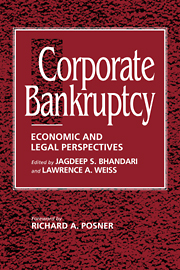Book contents
- Frontmatter
- Contents
- List of tables and figures
- Foreword by the HONORABLE RICHARD A. POSNER
- Preface
- Part I The role of credit
- Part II Bankruptcy as a reflection of the creditors' implicit bargain
- 4 A world without bankruptcy
- 5 Bankruptcy, nonbankruptcy entitlements, and the creditors' bargain
- 6 Translating assets and liabilities to the bankruptcy forum
- 7 Bankruptcy policy
- 8 Loss distribution, forum shopping, and bankruptcy: A reply to Warren
- Part III Beyond the basic creditors' bargain
- Part IV Workouts or bargaining in the shadow of bankruptcy
- Part V Alternatives to bankruptcy and the creditors' bargain
- Part VI Experience of other countries
- Index
4 - A world without bankruptcy
Published online by Cambridge University Press: 10 December 2009
- Frontmatter
- Contents
- List of tables and figures
- Foreword by the HONORABLE RICHARD A. POSNER
- Preface
- Part I The role of credit
- Part II Bankruptcy as a reflection of the creditors' implicit bargain
- 4 A world without bankruptcy
- 5 Bankruptcy, nonbankruptcy entitlements, and the creditors' bargain
- 6 Translating assets and liabilities to the bankruptcy forum
- 7 Bankruptcy policy
- 8 Loss distribution, forum shopping, and bankruptcy: A reply to Warren
- Part III Beyond the basic creditors' bargain
- Part IV Workouts or bargaining in the shadow of bankruptcy
- Part V Alternatives to bankruptcy and the creditors' bargain
- Part VI Experience of other countries
- Index
Summary
Introduction
At the Constitutional Convention in 1787, the only objection to giving Congress the power to pass uniform laws on the subject of bankruptcies was that bankrupts were occasionally put to death in England and that no similar fate should await debtors in this country. The answer to this objection at the Convention – and one fully borne out over the last two centuries – was that there was little danger of such abuse.
The first English bankruptcy statutes gave the creditors of a merchant, as a group, rights they did not have individually. These rights arose when a debtor committed certain specified acts. These “acts of bankruptcy,” as they were called, focused not on the financial difficulties of the debtor per se, but rather on actions, such as fleeing to “parts unknown,” that were thought to thwart the conventional efforts creditors used to obtain repayment. If a merchant committed a specified act of bankruptcy, creditors could petition the Lord Chancellor to appoint a commission that had the power to gather the debtor's assets together and sell them. The commission would then distribute the proceeds “to every of the said creditors a portion, rate and rate alike, according to the quantity of his or their debts.” If creditors were not paid off in full, “then the said creditor or creditors, and every of them, shall and may have their remedy for the recovery and levying of the residue of their said debts or duties … in like manner and form as they should and might have had before the making of this act.”
- Type
- Chapter
- Information
- Corporate BankruptcyEconomic and Legal Perspectives, pp. 29 - 38Publisher: Cambridge University PressPrint publication year: 1996
- 2
- Cited by

